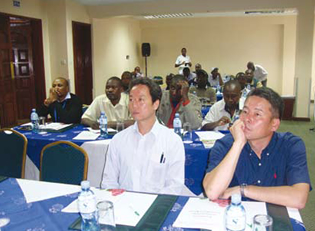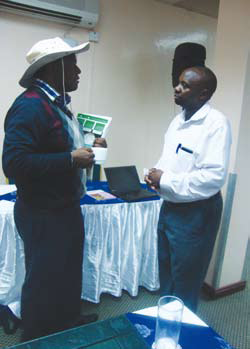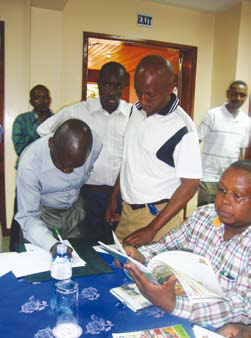 Expectations filled the air as one of the biggest chemical companies in the world, Arysta LifeScience, launched a fungicide for the control of Powdery mildew and botrytis and an insecticide for the control of all major insects mainly aphids, thrips, whiteflies, mealy bugs and hoppers and a miticide.
Expectations filled the air as one of the biggest chemical companies in the world, Arysta LifeScience, launched a fungicide for the control of Powdery mildew and botrytis and an insecticide for the control of all major insects mainly aphids, thrips, whiteflies, mealy bugs and hoppers and a miticide.
Time almost audio recorded voice of Mr.Richard Gitonga, the Regulatory and Development Manager-East Africa asked, Are you concerned by the ever increasing threat of resistance build up on fungicides and insecticides? Are you concerned of scotching flowers and leaving residues? Are you concerned of WHO class of your choice of product? Do you want to achieve your goals of IPM farming? Each of these questions received a resounding “yes” from the growers in attendance. “Today I stand in front of you to offer you solutions, Fungaflor, Teppeki and Kanemite”, he said
Welcome Fungaflor Bye.. Bye Powdery Mildew and Botrytis on Ornamentals
Growers preparing their Powdery mildew and Botrytis spray programs will have many options to choose including the newly launched Fungaflor. It was pomp and dance in a Nairobi hotel as Arysta Lifescience unveiled their new broad spectrum fungicide with preventive and curative treatment against mildew and excellent activity against botrytis. The fully systemic product has Imazalil as the active ingredient and targets all plants parts when sprayed. With a one day Pre-harvest interval, the product has no residual effects on beneficial insects and bees.
 Mode of Action
Mode of Action
Imazalil is a systemic fungicide from the group of N-substituted imidazoles. Members of this chemical class affect the cellular permeability barrier of the fungi. The fungitoxic action of imazalil on fungi may also involve the inhibition of the cell membrane functions. Uptake and membrane effects noted in several studies suggest that imazalil inhibits ergosterol biosynthesis in fungal cells.
Under natural conditions, the probability of the development of resistant strains of fungi is much lower with the polygenic system of imazalil than with the oligogenic system of the benzimidazole type fungicides. Most probably, occurrence of resistant strains to imazalil under field conditions is an extremely rare phenomenon which must involve 21 genes on 8 loci, linked with 6 groups (Laville et al., 1977; van Tuyl, 1977).
Characteristics
Fungaflor has a Novel Mode of action and does not inhibit sporulation or spore germination. It inhibits elongation and subsequent penetration of germination tube into plant tissues and has no cross resistance against other conventional fungicides is unlikely to occur (FRAC class: 3 G1).
Application
On Powdery mildew, it is advisable to start the first application at disease occurrence when symptoms appear. However, on Botrytis it should be applied as a preventative spray. In order achieve a good level of control it should be repeated every 7-10 days but in a high disease pressure situation; it is necessary to shorten the interval to 7 days.
Apply as a fine spray to ensure coverage, particularly the underside of leaves with a maximum of three treatments per crop cycle.
TEPPEKI: Hard on Pests Soft on Beneficials.
During the same meeting, Arysta Lifescience discussed Teppeki, its most spoken broad spectrum systemic insecticide. The insecticide is effective against all major insects namely aphids, thrips, whiteflies, mealy bugs and hoppers. Speaking to growers , Mr. Gitonga, said, “Teppeki” whose active ingredient is flonicamid, should be a flower farmer‘s best friend.
Teppeki has shown to be safe to a wide range of insects and mites used in IPM for roses such as Bombyx mori, Apis mellifera, Harmonia axyridis and Phytoseiulus persimilis”. The company says the active Flonicamid was discovered by the ISK Biosciences Europe, the manufacturing company and is betting on Teppeki to provide a new option to IPM programmes, thus in a way becoming a standard setting option.
 Mode of Action
Mode of Action
It acts by contact and ingestion. It is particularly effective against thrips (Frankliniella occidentalis), and also against other species such as aphids, mealybugs (Planococcus sp.), the greenhouse whitefly (Trialeurodes vaporariorum), yellow tea thrips (Scirtothrips dorsalis), green tea leafhopper (Empoasca onukii) or rice brown planthopper (Nilaparva talugens). There is a significant but limited knock down effect, as the insects cease to eat within a few hours after ingestion or contact. Unless ingested,it is also harmless to humans. In fact the company classifies it as non-eye and skin irritant.
Application
After maximum two consecutive applications, it should be alternated with at least two applications of products with a different mode of action. The application of Teppeki should be based on insect infestation and pressure. In so doing, cross resistance against other conventional insecticides is unlikely to occur. Its persistence when applied is between two to three weeks. That coupled with the fact that one only needs 120-140g/ ha makes Teppeki very economical for cut-flower farmers.
At the Oserian Development Company greenhouse where trials were done, the population of mealy bugs (Planococcus sp.), was reduced significantly to less than 10 bugs per plant when compared to untreated control after 21 days following two treatment applications applied at 7 days intervals.
Kanemite® – Promising Tool for Combating Mites
Let us jog our memories”, Mr. Gitonga said. “As a grower, when you see small brown dots on the leaves of a plant what comes in your mind? Out of curiosity, you tend to observe further and more closely, then your eyes meet very small strands of silk or webbing of plant especially underneath the leaves, what rings in your mind? One thing comes in your mind”. They all answered, “Mites”. “You need to add something else in your mind immediately you see these symptoms, Kanemite, your promising tool for combating mites”, he said.
Why Kanemite
Kanemite is a unique class of acaricide with good knockdown and excellent residual performance for both red mite and two-spotted spider mite. When used early, it can provide season long protection. It is Safe on beneficials and has a favorable worker safety profile. It is safe to the key mite predators and has an excellent fit in an Integrated Pest Management system. It has no cross resistance to other acaricides.
Mode of Action
Kanemite has a unique mode of action, research has shown that it inhibits electron transfer by binding to Complex III in mitochondria. This gives it a contact and quick knock down action to motile. It is among the few products which cover all mite stages from egg to adult with excellent efficacy on spidermites e.g Tetranynchus spp and Panonychus sp. Kanemite has a long residual performance and excellent efficacy on low temperatures and has no cross resistance with conventional miticides including Mitochondrial Electron Transport Inhibitors (METIs).
Safe to beneficial, environment and sprayer.
Research has shown that kanemite is the best product for your Integrated Pest Management (IPM) and hence a must use in your spray program. Before the recommendation, Kanemite was tested by International Organisation for Biological Control (IOBC) on beneficial on the different species of predatory mites, it was found to be harmless on Typhlodromus pyri, Amblyseius andersoni, Amblyseius womersleyi, Typhlodromus occidentalis and Phytoseiulus persimilis. On other beneficial, Kanemite was tested on differen species of parasitic Wasp namely; Aphidius rhopalosiphi and Encarsia Formosa. The results showed it was harmless. The product was also tested on carabid beetle, rove beetle, spider, green lacewing and lady bird. It was found to be harmless and safe to all beneficials.
Additionally, the product has Low oral, dermal and inhalation toxicity. It is non irritant to skin and eye and non sensitizing. This makes it very safe to the user. Kanemite breaks down readily in water and soil and then absorbed tightly to soil particles. It also has low toxicity to non-target organism except Daphnia magna. This makes it very safe to the environment.
Global registration status & Safety to Consumers.
Mr. Richard Gitonga further presented detailed MRLs data drawn from different tests done globally. He mentioned to the growers that the product is registered and is widely used in 9 European countries amongst them being Germany since 2006, Latin America, North America, Middle East, Asia and Africa. In comparison to the global standards in the different markets, the product proved to be very safe. This showed that the product is very safe for consumers hence can be recommended for any export markets.
